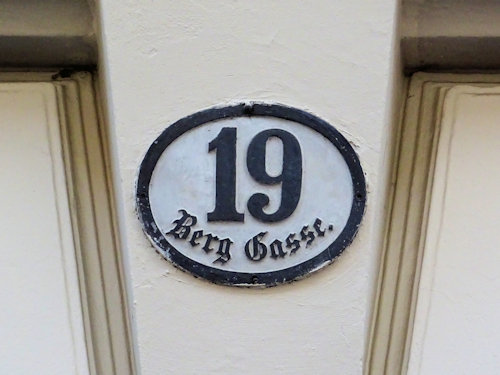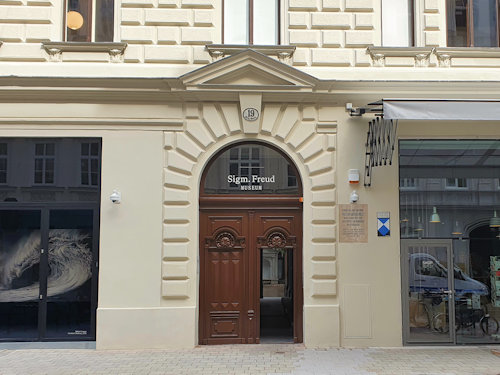Many Austrians enjoy enduring world fame, particularly the composers. But one name has achieved genuine iconic status despite his lack of sheet music: Freud. The Sigmund Freud Museum lets you explore the life and work of the father of psychoanalysis.
- View Freud’s former apartment and surgery
- Original documents, photos, objects, and more
- What special exhibitions are on?
- Excellent psychoanalysis-themed souvenirs in the shop
- Book Freud Museum tickets*
- See also:
Freud in Vienna

(One of Vienna’s more famous street addresses)
Sigmund Freud introduced the world to the idea of the psychiatrist’s couch. And, if you visit house No.19 on Vienna’s Berggasse, you can stand in the very room that witnessed the birth of this concept.
The couch itself – a gift from a patient – left with Freud when he fled Nazi-run Vienna for London (but see below for an on-site virtual alternative).
The Sigmund Freud Museum has plenty else to interest visitors, though.
Remarkably, the location is the very apartment that Freud lived in with his wife Martha, his kids, and his sister-in-law between 1891 and 1938.

(The entrance)
Freud received his patients here, too. Fortunately, surgery hours left plenty of time for him to buy groceries, look after the kids, and do the washing smoke cigars and write, two tasks he regarded as inseparable.
Given the volume of writing Freud produced, he must have single-handedly kept the Viennese cigar industry in business.
The museum is obviously a must for those with an interest in psychology and psychiatry. But you also get a feel for the intellectual life of late 19th and early 20th century Vienna, spanning a world war and the end of the Habsburg monarchy.
Inside the Museum

(The waiting room of Freud’s surgery; press photo © Hertha Hurnaus / Sigmund Freud Privatstiftung)
After an 18-month refit, the Sigmund Freud Museum reopened back in 2020 to offer a treasure trove of insights into the great intellectual.
The main exhibition occupies the apartment and surgery on one floor of the house. The rooms themselves contain few original pieces of furniture (with some notable exceptions), since Freud took everything with him when he “emigrated.”
The absence of furnishings is deliberate, a kind of monument that bears memory to the reason for that absence: Nazi oppression. Many areas, however, do retain much of their original design and fittings. Some also feature a photo of how they looked back in Freud’s time.
You cannot help but feel a certain frisson from standing, for example, in the study where Freud concocted his theories. Or in the bedroom where he had the dreams featured in his seminal work, The Interpretation of Dreams.
Gorgeous themed display cases made of burnished metal, glass, and wood introduce you to various facets of Freud’s life and work: Freud as father, translator, neurologist, cocaine user, traveller, refugee, and letter writer, for example. And, of course, Freud as scientific and cultural pioneer and innovator.

(Sigmund Freud’s former parlor; press photo © Hertha Hurnaus / Sigmund Freud Privatstiftung)
Documents, photos, books, and other objects fill each case. Among the highlights for those of a historical bent like me:
- The original Sigmund Freud doorplate from the apartment
- Freud’s doctor’s case from his early medical days (“Mild fever and a sniffle. Good. And are you sleeping OK? Any, ahem, unusual dreams?”)
- The original inlaid wooden table that stood in the Herrenzimmer (the room men would retire to after dinner). Imagine the conversations it would have witnessed
- The original waiting room furniture from his earlier premises on the floor below. Whatever your interest (or not) in Freud or his work, he’s an icon of the modern world. So it’s quite thrilling to see the actual sofa that people sat on before going through for treatment
- A small mirror from his study. Imagine how often it might have reflected a thoughtful face, trim beard, and cigar

(Plaque outside the museum noting its location as the former home and workplace of Freud, creator and founder of psychoanalysis)
As for the missing couch, well, a QR code in Freud’s former surgery leads you to an augmented reality app that allows you to “see” the item and listen to related information. Poignantly, the augmented image then fades.
Tickets, exhibitions & tips
An entrance ticket for or from the Sigmund Freud Museum includes the exhibitions within.
(Booking service provided by Tiqets.com*, who I am an affiliate of)
Special exhibitions
The museum always features conceptual and contemporary art along with (or in) the formal exhibition. And a major special exhibition on a particular theme. The current schedule for the latter is:
- Analysis Interminable (until September 22nd, 2025): a presentation of five existing schools of psychoanalysis
Some further tips:
- The ticket office is on the ground floor, along with a small shop and café (neither of which require a museum ticket to access)
- All display information is in both English and German. One or two audio stations dot the exhibition with, for example, a short interview with Freud and similar (you need to use your own headphones)
- The shop is mostly books but you can buy various souvenirs, too. I found an eraser marked “repression” (nice). Get the Sigmund Freud bath duck if you want to psychoanalyse yourself among the bubbles and soap suds
How to get to the Freud Museum
Subway: take the U2 line to Schottentor (short walk required)
Tram/bus: take the D to Schlickgasse or the 37, 38, 40, 41 or 42 trams to Schwarzspanierstraße (also short walk required). The 40A bus has a stop on Berggasse helpfully called, cough, Berggasse
Address: Berggasse 19, 1090 Vienna | Website
